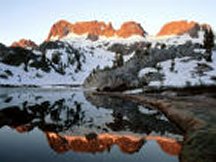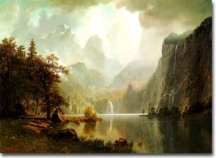Other bursts of
place-idity:
Cemeteries
Coffeehouses
Coming & going
Food & place
Islands
Maps as place
Mythical place
Placenames
Saving place
Trees
Visitors & place
 |

In a fundamental way that food and buildings and poets cannot overwhelm, rocks ARE a place. There isn't a place on Earth without them, providing shape and a sort of fingerprint that marks each region as itself, unlike all others.
I am a geology fan, in the way some guys sit down on Sundays and get themselves worked up about football, but then go on about their lives for the rest of the week except for occasional conversations that go, "Aaah, those Browns!"-- "Bah!"
I caught the bug from teachers in high school and college who were true devotees, and I might have pursued it further, but for an inability to recognize the rocks themselves ("Gabbro?" I hazard. "Micaceous schist, fool!" I hear). Since one can't go far in geology without having one's schists together, I quickly sought a more suitable career. But I never lost my attraction to stones and the bedrock they came from.
 |
 |
It may run in the family. My grandfather brought back from his travels wonderful lumps of pink and rose quartz for his rock garden out behind the garage; they were salvaged when he broke up housekeeping and now grace my father's garden along with great lumps of garnet someone else fetched from the Adirondacks, and water-smoothed hunks of fossil-rich shale from central New York.
Without any prompting, my daughter got it, too -- or else it's the magpie gene that all of us share and have to outgrow. At 2, she took so many pieces of decorative crushed marble from a neighbor's front garden that I had to buy him another bag. She gathered crushed shale from her grandfather's driveway -- to me, just fill, but to her, a souvenir of her trip. What was I to say? I have my share of such bits: Weathered, rounded, tan sandstone pebbles from off the New England coast -- maybe a few of them are marble; fragments of smooth limestone from New York creeks; a fragile piece of Florida sand cemented together -- in the process of becoming rock -- with lime from shells. On a trip to Alaska, we collected several pounds of rounded basalt (probably) pebbles, black with tiny flecks of quartz and sometimes a hint of coppery green, for a dripping-dish thing that we never completed. In my mind, the rocks became a symbol of the halcyon summer before 9/11, for it would never have been possible to lug those, and a handful of thrift-store silverware, onto an airplane afterward.
My household has several little collections of crinoid stems and bivalves set in shale, for my wife picks up stones, too. A book-sized hunk of coal down cellar, fished from a red-bottomed Kentucky creek where the only life was a green slime, reminds me of a trip and what I fear about mining.
The soft Devonian shales of my boyhood home cut like cake under the knife of glacial runoff, and after the glaciers went, streams that remained cut deep, fascinating gorges I loved to explore. My present hometown has the same pattern of glens and gullies, and it gives me pleasure to recognize them, buried as they are in the urban landscape. I guess it's a measure of my middle age that I've never clambered down inside.
Stones imprinted me with a couple of vivid memories. A piece of the Canadian Shield, a rusty, large-grained pebble that was wave-washed from a layer of sand at the bottom of a lake where we kids were playing, left me an image of sloshing around on a big truck tire, having fun in bright sunlight, and of shock and sudden pain when the girl next door beaned me. I must have been 6 or 7. I remember she was kept indoors all the next day to impress on her the gravity of stoning her friends. My sister suffered, too, because then she had no one to play with.
And a hunk of that Devonian shale, knocked loose by a friend I was climbing in a gorge with, sliced my eyebrow once. I remember I scrambled to the top and jogged down a safer slope to the stream at the bottom -- mainly fearful that if I didn't get the blood off my face and jacket, I would get busted and be forbidden to go up the gorge again. I guess I succeeded, but my oldest glasses still bear the bloodstain, if you look closely enough.
(Why do I still have a pair of 30-year-old glasses? I can't answer that.)
All the really gorgeous landscapes have good rocks. Well, not all of them, but the ones that sing to me. They're the bones of the place, durable and plastic; hard and unforgiving to the hasty and careless, but accommodating under the patient pressure of weight or water. I like rocks. I have never thrown one in anger.
